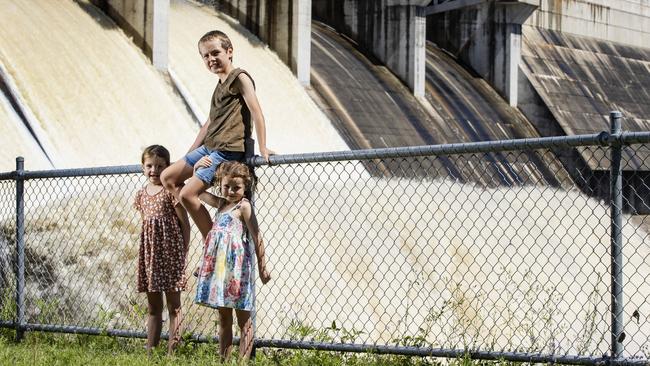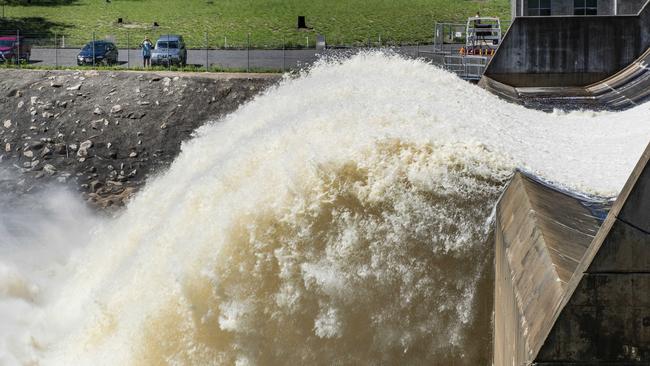Farmers hard hit but dams remain low after massive rain event
Major centres such as Warwick and Stanthorpe welcomed the replenishment of local dams this weekend but thousands of primary producers watched crops destroyed by the massive rainfalls.
QLD weather news
Don't miss out on the headlines from QLD weather news. Followed categories will be added to My News.
Thousands of Queensland primary producers have watched crops ripe for harvest destroyed by the massive rainfalls which also cut off south east Queensland town and flooded homes and businesses.
Major centres such as Warwick and Stanthorpe welcomed the replenishment of local dams.
Leslie Dam levels rose 46 per cent in just one month, from over 56 per cent capacity on November 3, to over 102 per cent capacity on December 2.
Local resident Leesa Latham and her three kids, Emily, 5, Abby, 7 and Jack, 9, watched water fall from the dam gates.
“It’s great for the kids to remember, we haven’t had water like this for a long time,” Ms Latham said.
“We’ve been on major water restrictions for a long time, so it’s good to have water.”
But the localised falls have failed to make significant impacts on the south east’s major water supplies which remain at low levels.
SES personnel were on standby as authorities warned that any further rainfall on already overwhelmed regions would quickly result in flash flooding or contribute to further sustained flooding.

QFES Commissioner Greg Leach said SES crews would be deployed if required.
“We have over 90 QFES personnel ready to be deployed across that area as required and we also have 3 aircraft so we can move people and equipment into affected locations quickly,” Mr Leach said.
As the clean up continues in the hard hit centres such as Inglewood 270km south west of Brisbane, the Queensland Government is offering $180 for individuals and $900 for families of five who are experiencing financial hardship due to flooding.
The SES was also working with local businesses to restock the town with petrol and food to assist a return to normality.
But the damage to crops is so extensive it will be enough to wind back Australian Bureau of Agricultural and Resource Economics and Sciences predictions last September of a $70 billion windfall for the nation on the back of big harvests.
In Mackay, hopes of a dry December to clear paddocks of the 2021 harvest were destroyed while cane harvested in the far north in the latter part of the year is recording lower sugar content because of heavy rain.
Falls in Mackay, which reached up to 300mm in 24 hours in the Paget region just south of the city at the start of the week, prevented farmers getting machinery of the ground to harvest canes and could cost the local economy more than $30 million.
Canegrowers Mackay chairman Kevin Borg said the crush could extend into the New Year, well past growers’ preferred early November finish date.

Across the south east hundreds of grain growers joined their New South Wales counterparts in abandoning the last part of the winter harvest because of rain, robbing them of the chance to cash in on record high grain prices.
Cattle producers are the one primary industry sector which has reaped positives from heavy falls which continue to push the state out of drought which has kept more than 60 per cent of the state in its grip for the past eight years.
AgForce CEO Michael Guerin says if last week’s falls are followed up by good summer rains a large tract of the state can expect to come of drought declaration
The only downside was massive road closures which the RACQ put at around 350 across central and southern Queensland, leading to problems in cattle transportation and a slow down at abattoirs.
Queensland Premier Annastacia Palaszczuk told State Parliament last week the south east water grid was at 59.5 per cent capacity with a four per cent rise over the week.
“This means … we are unlikely to face water restrictions in southeast Queensland this summer,” Ms Palaszczuk told Parliament.
Queensland flood emergency: One dead, towns swamped as floodwaters still rising
The south east’s water grip actually ticked over 61 per cent by Friday afternoon but there is concern among hydrologists that the massive Wivenhoe Dam above Brisbane remains at just over 43 per cent.
Rain remains urgently needed to further replenish the dam to counter the rapid evaporation that comes in the Summer months.
If the Wivenhoe catchment received no or little rain over the next few weeks, experts estimate it will take at least 100mm of falls for the dried out catchment to resume sending inflows into the dam.
The state’s rapid population growth over the past two decades is putting enormous pressure on existing water resources.
But the state already has the capability of generating an extra 60,000 megalitres annually via a purified water recycling system which the State Government outlined in its bid for the 2032 Olympic Games.
ends.


